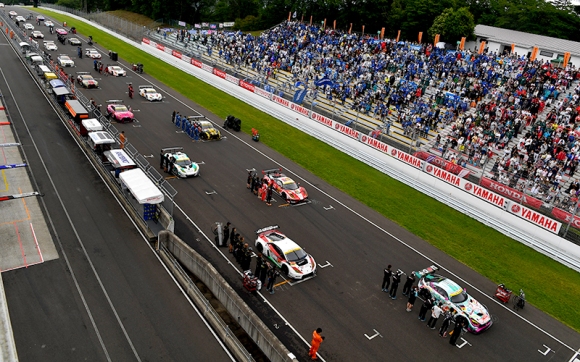The GT Association, sanctioning body and promoter of the Autobacs Super GT Series, released part of their 2017 Sporting Regulations to members of the press today, outlining two key changes in race procedure and success ballast. The entire document is expected to be released tomorrow.
As part of the changes outlined today, the Sunday Free Practice session has been abolished, and fuel flow restrictors will return to the equation in GT500 success ballast with a new three-stage system.
First, the schedule for each race meeting will be streamlined, with the thirty-minute Sunday Free Practice session being scrapped in favour of a longer pre-race warm-up period, increased from eight minutes to twenty before cars go to the grid.

To replace the Free Practice session, there will be a pre-race talk show with the top three drivers from Saturday qualifying, and a driver introduction ceremony. (Brief Editorial: Our sincerest hope is that driver introductions are anything like the opening ceremonies of Pride Fighting Championships of yesteryear, MC Lenne Hardt included.)
The GT Association also set the outright maximum entries for the series at 48 cars total. Circuits will be able to set their own maximum capacity, with those numbers set to be published later, perhaps as soon as tomorrow with the remainder of the 2017 Sporting Regulations.

But the biggest change affects success ballast in the GT500 class, with fuel flow restrictors returning to the equation after a year out in 2016. This time, however, fuel flow restrictors will be distributed in a three-stage system, as no car will be made to carry more than 50 kilograms of physical ballast at any time.
Fuel flow restrictions begin once a car has exceeded 50 kilograms of success ballast in the course of a season. The first stage of fuel flow restrictions occurs at 51 to 67 kilograms of ballast, where the fuel flow will be reduced from the standard 95 kilograms/hour to 92.4 kg/h, a reduction of just over 2.5 percent.
The second stage occurs at 68 to 84 kilograms of ballast, where the fuel flow is reduced to 89.8 kg/h. And the final stage occurs at 85 up to the maximum 100 kilograms, where fuel flow is reduced to 87.4 kg/h – a net reduction of 8 percent down from the standard 95 kg/h.

The tradeoff in the reduced horsepower that comes with the fuel flow restrictors will come in the form of less physical ballast to affect the cars’ handling, braking, and tyre wear capacities.
GT300’s success ballast platform will remain unchanged, with cars accumulating up to 100 kilograms of physical ballast only over the course of the season.
Success Ballast will continue to be distributed at 2 kilograms per championship point for the first six rounds of the championship, then reduced to 1 kilogram per point in the penultimate round at Buriram, Thailand, before being removed completely for the season finale at Twin Ring Motegi.
More changes are expected to be outlined when the complete list of Sporting Regulations for 2017 is published by the GT Association.
Special thanks to Geinou of RacingBlog.de for providing the information detailed in this story.
